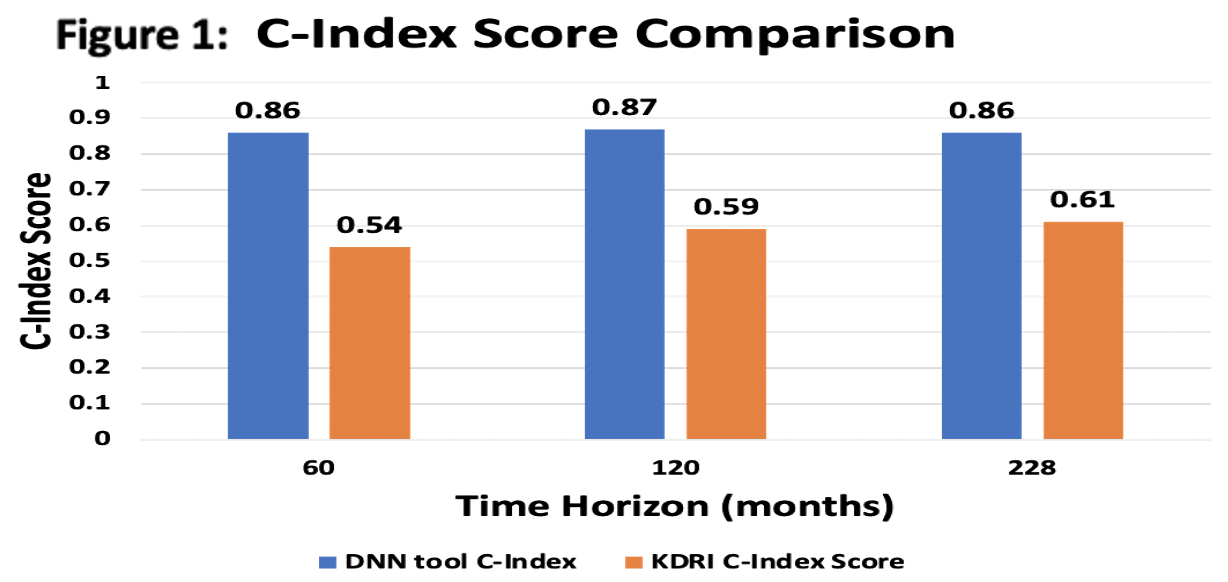Artificial Intelligence Algorithm Predicts Kidney Transplant Outcome by Using Donor-Recipients Factors: Study of 142,971 Transplant Pairs
Sana Mohseni1, Orkideh Olang1, Amir Sabet1, Nick Sajadi2, Ebrahim Pourjafari2, Amir Samiezadeh2, Mohammad Alavinia3, mohammad shafiee1.
1General Internal Medicine, Toronto General Hospital, Toronto, ON, Canada; 2Ortho BioMed Inc., Toronto, ON, Canada; 3KITE Toronto Rehabilitation Institute, University Health Network, Toronto, ON, Canada
Introduction: Organ shortages are a pressing issue, with over 100,000 Americans in need of life-saving transplants [1]. Those suffering from End Stage Renal Disease (ESRD) suffer the most, with 12 dying every day [2]. This issue must be addressed by improving graft survival prediction before transplantation. There are multiple reasons why current medical decision-making tools are not accurate. One potential reason could be their tendency to consider only donor factors. To address this, we propose an Artificial Intelligence method that can predict individualized transplant outcomes by learning from the complex interactions between donor and recipient.
Methods: A deep neural network (DNN) tool was developed and trained on a dataset of 142,971 records of donor-recipient pairs and 472 kidney-related variables from the Scientific Registry of Transplant Recipients (SRTR). Follow-up data were available from 2001 to 2020 for transplants performed from 2000 to 2019. The DNN model was used to estimate a Probability Distribution Function (PDF) for transplant outcomes. Furthermore, all matches were assessed according to the Kidney Donor Risk Index (KDRI). PDF expected values were compared to KDRI scores using the Concordance Index (C-Index) score, which is the proportion of correct ordinal predictions divided by total predicted values. Three cumulative follow-ups of 60, 120, and 228 months were analyzed.
Results: The DNN tool demonstrated a strong ability to predict transplant outcomes, with C-Index scores of 0.86 (95% CI: 0.79-0.87), 0.87 (95% CI: 0.83-0.89), and 0.86 (95% CI: 0.82-0.87) at 60, 120, and 228 months post-transplant, respectively. In comparison, KDRI had C-Index scores of 0.54 (95% CI 0.53- 0.55), 0.59 (95% CI: 0.57-0.60) and 0.61 (95% CI: 0.60-0.63) at the same follow-up periods, depicted in figure 1. Our results showed that the DNN tool had a significantly higher prediction capability in all follow-up times (p≤0.05) and could predict transplant outcomes with higher accuracy than KDRI in all follow-up periods.

Conclusion: This study demonstrated that a DNN tool can improve the prediction of transplant outcomes. According to the C-Index, a metric representing organ matching accuracy, DNN offers better organ allocation than KDRI. With its ability to analyze complex relationships between donor-recipient variables, our DNN tool enhances insightful matchmaking. In turn, this results in better transplant outcomes and efficient organ utilization. To validate the performance of this tool prospectively, future studies are needed.
We sincerely thank Health Canada for their kind support and funding of the challenge ”Machine learning to improve organ donation rates and make better matches” (Challenge ID: 201906-F0022-C00008)..
References:
[1] Organ Procurement & Transplantation Network.https://optn.transplant.hrsa.gov/patients/about-transplantation/transplant-process/
[2] National Kidney Foundation Consensus Conference. https://www.kidney.org/news/report-national-kidney-foundation-consensus-conference-to-decrease-kidney-discards
Lectures by Orkideh Olang
| When | Session | Talk Title | Room |
|---|---|---|---|
|
Tue-02 14:00 - 14:25 |
Abstracts Session 4 | Deep neural network model can effectively determine and rank the predictors of failure after kidney transplantation in patients younger than 18 | Grand Georgian |
|
Tue-02 14:00 - 14:25 |
Abstracts Session 4 | Artificial Intelligence Algorithm Predicts Kidney Transplant Outcome by Using Donor-Recipients Factors: Study of 142,971 Transplant Pairs | Grand Georgian |
